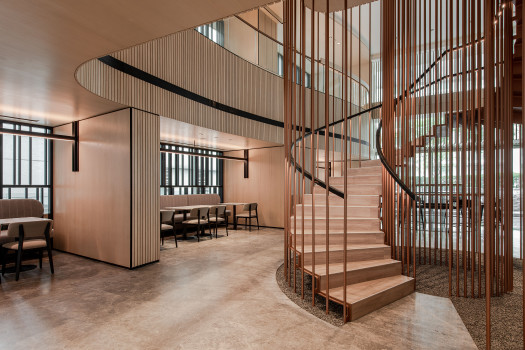Managing in uncertain times



Richard Harris is one of New Zealand’s most experienced architects and practice leaders. Now running his independent company, he was a co-founder and long-time director of Jasmax, a past president of the NZIA and a Distinguished Fellow of the Institute. In his career, from graduate to practice director, he has encountered – and survived – several significant economic downturns. He discussed his experience of difficult times, and the lessons he learnt, in a webinar addressed to NZIA members. This article is based on that presentation.
At the start, I would like to share something important: in my career, I have found that how you act in difficult times shows more about your character than how you act in easier times.
In the architecture profession, as in all other areas of life, we face:
Health threats to ourselves and our families, and our colleagues
Economic threats, including to the viability of businesses.
The impacts will not play out equally amongst us. We all need to look after those who are worse affected than us. Check in on anyone who is vulnerable and offer what support you can.
Through these challenging times, we can demonstrate that, in architecture, we are a community that cares. This is a unique time to forge supportive networks. The Institute has stepped into this role and already issued targeted and useful communiques, but we each need to do our bit, too.
I am aware I am talking to graduates, architects, employees and owners of small and large practices. My experience has been shaped by being all of those at one time or another.
I was an out-of-work graduate in the late ’70s global oil-shock recession. I was a young architect with two young children, a big mortgage and a new practice when the share market crashed in ’87. And I was NZIA President at the time of the ’08 GFC – I took direct calls from many worried NZIA Members. I understand how hard it will be for some of you.
My challenge is to draw on that experience to impart something that is useful to each of you as you seek to find a pathway through the economic situation we confront. Some of you will have had different experiences of past economic shocks, and the architectural community will benefit from your input, too.
Mindset
I want to start with mindset. In a situation like this, it is natural to feel a sense of dread – to have anxiety, broken sleep and butterflies in the stomach. Don’t beat yourself up about this; look after yourself, physically and mentally.
When the stock market crashed in October 1987, I was in my mid-thirties and, together with a colleague, led a two-year-old architectural practice with 12 staff. Three weeks before the Crash, we had moved into a new multi-storey office building we had designed, having signed a 6-year head lease on a whole floor in anticipation of our rapid expansion – heady days!
The crash induced in me all of the feelings identified above. I had a real sense of despair which was lifted in good measure by reading an old NZIA Newsletter I was throwing out. It was from 1976, and it reflected on the then-current downturn. On the subject of real estate vacancies, the article noted that over the earlier part of the 1970s, New Zealand had built enough commercial and residential space to satisfy a whole generation of demand. The conclusion was this would have a deleterious effect on architects for 25 years out.
Now I was reading this 11 years later, after the nation had not only weathered that recession but had gone through the biggest building boom of its history. That showed me that everything is cyclical, and that there will be light at the end of the tunnel quicker than might be imagined – certainly quicker than 25 years!
This allowed me to carry a positive mindset to finding pathways through the ’87 and subsequent recessions.
Previous shocks
While the late 1970s recession in New Zealand and the United Kingdom had a personal effect on me – there wasn’t an architectural job to be had in the UK, where I lived for a couple of years, and my first job experience back in New Zealand was ‘short-lived’, i.e., ended in redundancy – the major events were the ’87 crash and ’08 GFC. Interspersed between these events were the late ’90s Asian economic crisis, the dotcom bubble of early 2000, and a variety of other blips in the economy. And, of course, those occasional crises of insufficient work – familiar to us all – that could be just as well ascribed to an unfortunate alignment of the planets.
The ’87 crash
During the ’87 crash, our practice had a variety of projects, but 80 per cent of our billing was with one client. Within 18 months that client had gone into receivership, leaving us with a big bad debt. But the beauty of that 18-month breathing space is that we had prepared for that client’s demise by rapidly and successfully seeking alternative revenue streams and reducing unnecessary costs. The net result was that the year in which our bad debt was incurred was also our best financial year to date.
What did we do wrong?
We believed that the upward slope of our revenue and growth was forever
We had too great a percentage reliance on a single client
What did we do right?
When we created the company, we established a strong vision and retained this through the tough times
We created a recession plan and stuck to it
We moved quickly
We engaged our staff in marketing efforts to spread the impact
We chased money owed
We established a co-working space in our office
We set up separate offices sharing common facilities to share rental costs. One of those is still in the building!
In ’89 I was a co-founder of Jasmax, in a merger. The impact of the crash was still playing out – in 1990-91 the effect of the ’87 crash was near its worst.
I renegotiated a more favourable mid-term lease on our Wellington premises, becoming good friends with the landlord’s property officer in the process. It was tricky, because although we had just won the competition for Te Papa, we were cash poor. Luckily, the property officer understood.
I negotiated recovery of bad debt with the receiver for the Majestic Building in about 1993.
My observation is that even if the country is in the recovery phase, there is still mopping up to do so five or six years later.
The 2008 GFC
With the GFC in 2008, the effect on the architecture profession was again a quick shock rather than a slower slide into a recession. At the time we didn’t know whether it would be a recession (two subsequent quarters of negative GDP) or a depression, which is much longer. We weren’t as well placed as we would have liked to be, but we did have some longer-term big projects that could carry us for a while.
What did we do wrong?
We believed that the upward slope of our revenue and growth was forever – our scenario planning ranged from optimistic to exceedingly optimistic
Our spending was commensurate with our assumed income
We kept burning staff time on big projects that had a 90% chance of failing with us not getting paid – we effectively buried a huge sum on a hillside in Queenstown. (The upside was for staff who were employed for longer).
What did we do right?
We developed a plan and took quick action on numerous fronts
We were transparent and supportive with staff. We knew we had to make redundancies, but we were determined we would adopt the best possible practice to support staff
We had a good diversity of projects
We maintained good base revenue and the year in which our bad debt was incurred was our best financial year – partly because we had addressed our costs on the basis that the recession could be deeper than it turned out to be
We proceeded with a lease on new premises in Parnell, because we believed that the benefit to the company and culture was bigger than the risk.
As you can see, there are real risks in not learning from previous experiences. Blind optimism is as contagious as despair. Learning from my experience, I believe it is a good policy to have a ‘go/no go’ regime where you reflect on the benefits and risks of taking on projects. This enables the process to be conducted in a cool, calm and collected manner away from the adrenaline-fuelled addictive excitement of the ‘hunt, chase and start drawing’ routine. The latter method usually proceeds a phase where the following can be heard – ‘Oops, where is our contract?’, and ‘Damn, I thought the client would pay for that’.
The same approach applies to continuing with a project and take the risk of digging a bigger hole for the company. Learn when to fold and learn how to do it safely.
It is challenging, because if you suddenly pull resources you could well be liable for a collateral damage suit from the client that vastly exceeds what you would have spent in continuing.
Are the lessons learnt from the shocks of ’87 and ’08 relevant to the current shock? I believe they are. There is a planning process to go through that is similar. And, as I experienced, it is the same process for a smaller firm and a bigger firm. I will get to planning in more detail but first I will focus on immediate actions.
Quick actions
Cash flow
The saying you’d hear in recession times was ‘Cash is King’. You need cash because it is harder to get credit. Therefore, both personally and as an organisation, cash preservation comes into sharp focus.
As the NZIA advised in a recent Bulletin, check in with your bank manager and your landlord. And as the NZIA has also urgently advised, check to ensure that you are getting all government and bank-related assistance that you can at this time.
Ask your bank for relief and a review of interest rates. Banks now need to take on board the needs of their community rather than just their shareholders. If they reject you, ask why and come back again.
A bank will want to ensure that your debt/equity is balanced. Can you restructure your finances to reduce debt? Is there anything you can sell? Do your homework before going along and outline the process you are going through to put your yourself or your practice in a better position.
You also need to understand your trading position and your break-even point. But don’t manage your company by your break-even point.
Look at your fixed costs in relation to your variable costs. Would it be more effective to convert a fixed cost to a variable one, or vice versa? Do the math. Check through all your outgoings and develop a strategy for reducing costs on each of them. Ask, ‘Do I need this?’, ‘Is it beneficial?’, ‘Will it help me with where I want to go?’
Review licenses, software and hardware. Can you renegotiate? Don’t assume you can’t be persuasive. Look at all your suppliers – could you do better elsewhere? – but before changing, check in with your current one.
Staff
A big cost is usually the wage bill. You need to address this to ensure that your costs don’t exceed your income for a sustained period. Employment and staff relations are always sensitive issues, but acutely so at a time like this.
Business owners will be facing hard decisions but need to keep the human dimension central in planning and implementation.
Business owners should get good advice if they are uncertain of HR law but should not let the legal approach undermine the human approach. (The growth of HR sections in bigger firms has highlighted how critical it is to have empathetic people in HR leadership roles.) Practice leaders, as they develop and implement their plans, should involve staff and provide a support framework for them.
The next weeks and months are going to be very challenging for practices and their staff. To preserve as many jobs as possible, consider options such reducing salaries, reducing hours and job sharing. Some people may want to convert to a casual basis. And, again, take advantage of the Government’s wage subsidy and business support schemes.
Leave can also be a big liability on your books, so work out how best to reduce this liability in a way that works for all.
Getting paid
Clearing your debts is a good way of improving your equity ratio. It may be possible, in our current circumstances, to negotiate a debt clearance at a discount.
It is very important to focus on maintaining an income and getting paid. That said, don’t send out unexpected big invoices with every retrospective charge you can dream up over the life of the project. That is a good way of not getting paid, or in fact, getting sued. Manage your clients’ expectations throughout this process.
Another factor to consider is loss-making projects. Do you need to continue with them, or can you renegotiate the fee to continue? The answer may depend on the quality of the client, the agreement you have with them, and their flexibility. Look closely at all the ongoing work on your books and form a view on each project and each client. Despite the exigencies of these times, it may well be best to have less work than work that may seriously weaken your company.
And, if a situation calls for it, consider suspending services. But don’t do this lightly or without consideration of potential reaction from the client – take advice on this prior to action.
Opportunities
Don’t waste a good recession!
There are three different phases of a recession that I have experienced: going in; being in; coming out. How you play each phase determines your success at the following phase. Have a view of how you want to emerge from the recession.
You need a plan. As the saying goes, ‘If you fail to plan, you plan to fail’. We are heading into an environment that will be very different; there will be a new normal. You are basically seeking to align your skills and capability with a changing market. There are some planning tools that can help you navigate these challenges and are useful, no matter how small your company is.
The first exercise is to determine what that market might look like, the second exercise is to determine how you are positioned to meet it, and the third exercise is to determine different scenarios for a way forward.
A strategic planning tool called PESTEL allows you to scan for opportunities in the market by looking through the following lenses:
- Political
- Economic
- Social
- Technological
- Environmental
- Legal
Once you have undertaken this scanning exercise and filtered the opportunities, you can then do a SWOT analysis to see how well-aligned you are for those opportunities.
Finally, you can undertake some scenario planning where you look at different scenarios, for example, the duration of the recession.
Whether you use some of those techniques to assist you or not, you still need a plan. It doesn’t need to be too complex; in many ways, the simpler the better. This is also a perfect time to look at your practice or employment role and decide if that is the way you want to go forward. Perhaps it is, but maybe it’s time for a change: leave a practice and start a new one; restructure your practice; close your practice and become an employee; merge with others.
A recession requires us to prepare a plan – it becomes a necessity. Use that momentum to reconsider your own and/or your company’s position. There is no better time.
Potential traps that leave practices vulnerable:
- Lack of diversification
- Too much reliance on a single client or narrow client base
- Accepting fee gouging in a downturn
- Accepting lopsided fee agreements
- Ignoring your best clients – the first opportunities start with your existing clients
Keeping your worst clients – focus more on your client base than the projects. A good project with a terrible client would need a great strategic reason to make it worthwhile.
How should we act?
- Your character and values are on greater display in hard times than they are in good times.
- Display genuine empathy, concern and support for the welfare of those you work with
- Get closer to your best clients in tough times, and in doing so you may find you make them a client for life! How bad is that?
- Act with integrity
- Act with honesty
- Act with transparency
- Act with flexibility
- Support
- Ensure that you and your staff are well supported through this very difficult time.
- Make use of Practice Support Groups
- Make use of the NZIA’s network, support and advice
- Find a mentor
- Support a colleague.
Finally, I wish you all well through these challenging times. Good luck, take care and, although you will be worried, try and use this time to think – positively! – about the sort of professional future that could work for you.
This article was first published by the New Zealand Institute of Architects (NZIA)




 Indonesia
Indonesia
 Australia
Australia
 New Zealand
New Zealand
 Philippines
Philippines
 Hongkong
Hongkong
 Singapore
Singapore








